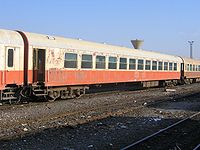- Organization for Cooperation of Railways
-
The Organization for Cooperation of Railways (OSJD or OSShD) (Russian: Организация Сотрудничества Железных Дорог or ОСЖД), was established as the equivalent of the International Union of Railways (UIC) to create and improve the coordination of international rail transport. Concerning especially the transports between Europe and Asia, it has helped develop cooperation between railway companies and with other international organisations. The members of this organisation created an international transport law.
Contents
History
At a conference in Sofia, Bulgaria on 28 June 1956, the governmental ministers managing railway transport of Eastern bloc countries Albania, Bulgaria, Hungary, Vietnam, East Germany, China, North Korea, Mongolia, Poland, Romania, the USSR, and Czechoslovakia decided to establish a special inter-governmental organization, the executive body of which started operations in Warsaw, Poland on 1 September 1957.
In contrast to Western European countries, railway links between OSShD member countries are characterized by long routes (8000 to 10,000 km), different and severe climatic zones, and two track gauge changes on a single route (1435/1520/1435 mm). Focusing on collective resolution of railway transport problems, OSShD role has developed with new frontiers increasing freight transport times.
Transport between Europe and Asia is controlled by different regulations from Western Europe, such as the Agreement on International Passenger Communication (AIPC), Agreement on International Freight Communication (AIFC), Rules of Mutual Use of Railway Cars (RMURC) and Agreement on Rules of Settlements Between Railways.
OSShD also improves the technical, legal and tariff compatibility between OSShD members and transport systems in Europe.
In 1990, OSShD consisted of 13 member countries (Albania, Bulgaria, Hungary, Viet Nam, GDR, China, North Korea, Cuba, Mongolia, Poland, Romania, the USSR, and Czechoslovakia). In 1992, it was joined by the six newly-independent states of Belarus, Latvia, Lithuania, Estonia, Moldova and Ukraine. The reunification of Germany influenced the participation of the former East-German Deutsche Reichsbahn, which took observer status.
In 1992 in Ulan Bator, a new Conference of Railway General Directors was formed. This encouraged between 1993 to 1995, seven countries to join: Azerbaijan, Georgia, Kazakhstan, Kyrgyzstan, Uzbekistan, Tajikistan and Turkmenistan. This created 24 active member countries in total.
In 1997, Iran joined the OSShD, with Germany, France, Greece and Finland joining as observers. Additional, 17 commercial members joined, including: Siemens, Alcatel, Plasser & Theurer, Intercontainer-Interfrigo, Kolmex, and TransManche Link/Eurotunnel.
Operations
Europe-Asia freight operations
The main theme of the OSShD is in the programme for perfecting railway links between Europe and Asia. The OSShD defines success as the increase in freight volume that can be achieved both by direct investment in technical equipment, and by rationalization and improvement of existing procedures and services. The major programme provisions were presented at international conferences and published in Schienen der Welt, 4, 1995. The freight and passenger volumes between Europe and Asia, and the major railway flows were defined within the implementation of this programme, taking into account the activities in Europe of UIC, UN, ECE Inland Transport Commission, and the Trans-European Main Line Railway Programme
Routes
- Druzhba-Alashankou crossing point - in 1994, the Ministers of Transport of Russia, China, Uzbekistan, Turkmenistan, Kyrgyzstan and Tajikistan, approved the regional programme for development and use of the international railways via the border crossing-point Druzhba-Alashankou until the year 2000
- Berlin-Warsaw-Minsk-Moscow corridor - in 1995, the Ministers of Transport of Belarus, Germany, Poland and Russia signed a cooperation agreement on modernization, reconstruction and development of the Berlin-Warsaw-Minsk-Moscow corridor
- Korea-Germany freight train
Legal
Agreements on international freight communications and the Carriages of Goods by Rail (CIM), and new rules on transporting dangerous freight prepared by OSShD based on UN recommendations and the Regulations governing the International Carriage of Dangerous Goods by Rail (RID).
OSShD is also participating in preparation of the new convention on customs regulations in international railway freight within the framework of the UN ECE Inland Transport Commission to be presented at the UN ECE Inland Transport Commission forum in 1998.
Equipment
 OSShD-Y passenger carriage, in use by Chemins de Fer Syriens in Syria, made in German Democratic Republic
OSShD-Y passenger carriage, in use by Chemins de Fer Syriens in Syria, made in German Democratic Republic
OSShD has created various technical standards, which allow each companies equipment to attached to others, as well as specification for initially freight vehicles and then passenger carriages which each member could order to ensure cost efficiency/inter operation
Part of involved the creation of a common specification for variable-gauge wheel sets, designed for use on the 1435 and 1520 mm gauges. OSShD is also works on technical problems of different push-pull devices, brakes, car sizes, etc.
Carriages
In 1962 the East German railway company Deutsche Reichsbahn introduced a new generation of 24.5m four-axle coaches, termed OSShD Type B (OSShD-B), on "Görlitz V" bogies.
From 1968 this was further developed to met UIC-standard, and became known as OSShD-Y. Built by VEB Waggonbau Bautzen or VEB Waggonbau Görlitz in East Germany, the 24.5m carriage was characteristic by its arched top, rather than the Type-B curved top. Supplied to all OSShD members, it was often the basis for the bulk of many OSShD members stock, as well as being sold on to other railway companies.[1]
Future work
OSShD is presently working in the areas of
- Specification of technical parameters for high-quality freight lines
- Confirmation and simplification of legal regulations on procedures at frontiers related to transportation across Eurasian continent, delivery terms, financial responsibility, etc.
- Creation of competitive conditions for acceptance and carriage of large freight volumes to improve OSShD members' financial conditions
- Development of new forms of freight carriage by block freight trains from large-scale senders to large-scale receivers in shortest possible time at competitive prices
See also
- Intergovernmental Organisation for International Carriage by Rail
References
- ^ "OSShD-Y". activitysimulatorworld.net. http://www.activitysimulatorworld.net/La_documentation/MSTS_CZ2.pdf. Retrieved 2009-05-03.
External links
Categories:- International rail transport
- Railway associations
- Rail cooperatives
Wikimedia Foundation. 2010.


